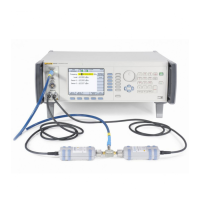3-1
Chapter 3
Performance Tests
Introduction
Warning
To prevent possible electrical shock, fire, or personal injury:
• Do not perform the verification tests or calibration
procedures described in this manual unless you are
qualified to do so. The information provided in this manual
is for the use of qualified personnel only.
• Restrict the humidity of the operating environment to the
level specified for any equipment used that conforms to
IEC60950-1 used with the Product.
Recommended Tools and Equipment
A list of the tools and equipment required to verify and maintain the performance
of the Instrument is shown in Table 3-1. If the recommended model is not
available, use another model/brand with the same or better specifications.
The Power Meters and associated Power Sensors listed in Table 3-1
automatically apply corrections for the sensor frequency response, linearity, and
temperature. However, to achieve best uncertainties it is common practice to use
these devices with additional calibration factor correction figures obtained by
calibration at a primary laboratory or a national metrology institute, usually
measured at a single power level. The diode sensor designs include
compensation for inherent non-linearity of the diode amplitude response, but at
certain test points these “built-in” corrections alone are not sufficient to achieve
the required measurement uncertainty. In addition to the usual frequency
response (or “flatness”) calibration factors, corrections must be applied for a
frequency dependent linearity characteristic. These could be determined at the
time of frequency response calibration, or determined separately by comparison
with an inherently linear device such as a thermal Power Sensor.

